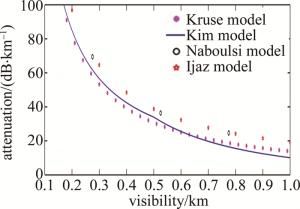HTML
-
激光具有单色性好、方向性强、亮度高等优点,被广泛应用于自由空间光通信[1-5],但其通信传输链路极易受到雾天的影响。由于地理位置的不同,微粒的浓度及尺寸分布会发生变化,通常雾的微粒尺寸分布是无法得知的,气象数据里也没有提供。因此,经验模型是预测雾衰减的一种重要方法。1962年,KRUSE等人[6]在实验的基础上利用能见度定义与雾的物理特性,分析了雾的衰减系数模型。2001年,KIM等人[7]基于观察不同波长的激光在雾天的衰减系数变化,利用完整的米氏散射定理对Kruse模型进行修正。2004年,NABOULSI等人[8]考虑平流雾和辐射雾两种特殊天气情况,应用米氏散射定理与修正的伽马(gamma)分布进行建模。2013年,IJAZ等人[9]建立了一个受控的室内实验室,利用获得的实验数据提出了一种新模型来预测雾和烟的衰减系数。2016年,ESMAIL等人[10]利用米兰、尼斯、布拉格和华盛顿4个地方获得的衰减系数实验数据,提出了衰减系数经验模型。
尽管现有的雾衰减经验模型有很多,但将模型应用到实际中的适用性分析较少。针对此问题,本文中仿真计算了不同经验模型激光在雾中传输的衰减系数,搭建了波长为650nm的激光在雾中传输的衰减实验平台,分析了不同雾衰减模型在西安地区的适用性,为西安地区自由空间光通信系统雾衰减系数分析提供了参考依据。
-
雾滴对激光信号的衰减主要取决于雾滴的尺寸分布、散射截面和吸收截面。一般情况下,雾滴的尺寸分布服从修正的gamma分布。雾滴尺寸分布函数n(r)表示为[11]:
式中, a,α,b,β为雾滴的特征参量,r为雾滴粒子的半径。雾滴谱模型中广泛使用的是α=2,β=1的gamma分布,即Khragian-Mazin分布模型:
式中, 如果r以m为单位,则有:
式中, V表示能见度,W表示含水量。将(3)式和(4)式代入(2)式,利用雾的含水量和能见度之间的关系,得到两种雾滴尺寸分布。
平流雾:
辐射雾:
-
近红外区及可见光波长的激光在雾天气条件下发生的散射属于米氏(Mie)散射。由Mie理论得知,粒子的散射截面可以表示为:
式中,k是波数; o是项数; zo和bo是Mie散射系数,它们是关于复折射率、波长、粒子半径的函数。雾引起的信号衰减可由衰减系数表示,衰减系数A由下式计算:
1.1. 雾滴尺寸分布
1.2. 米氏散射理论
-
Kruse模型自1962年已被广泛用于预测衰减系数,其模型为[6]:
式中, λ是激光波长。该模型用来估计可见光和近红外波段的衰减。q是与微粒尺寸有关的系数,其值为:
-
2001年, KIM对Kruse模型进行修正。基于精确的Mie理论计算,对Kruse模型的系数进行如下修改[7]:
-
NABOULSI利用Mie散射理论和改进的gamma分布对信号衰减建模,提出了平流雾和辐射雾两种衰减预测模型,其中辐射雾的衰减系数可以表示为[8]:
此模型用于激光波长为690nm~1550nm的大气衰减系数预测。
-
IJAZ建立了一个受控的室内实验室,测量了波长为600nm~1600nm激光的衰减系数,提出了如下模型[9]:
式中, q(λ)=0.1428λ-0.0947。
-
为了更好地比较大气衰减计算模型,仿真分析经验模型的大气衰减系数与能见度的关系。图 1是波长为1550nm的激光在Kruse模型、Kim模型、Naboulsi模型和Ijaz模型中的衰减系数随能见度变化的曲线。从图 1可以发现, 4个模型的衰减系数都随能见度的增高而减小。Kruse模型与Kim模型的衰减系数差值较小,Naboulsi模型与Ijaz模型的衰减系数差值较小。在能见度较低时,4种模型的衰减系数差值最大,其中,Ijaz模型的衰减系数值偏大,随着能见度增高,模型间的衰减系数差值变小。
2.1. Kruse模型
2.2. Kim模型
2.3. Naboulsi模型
2.4. Ijaz模型
2.5. 仿真分析
-
为了更好地将大气衰减计算模型与实际衰减情况进行比较,作者在西安地区进行为期半年的实验研究。实验装置如图 2所示。
系统的工作流程是: 发射端激光器产生用于通信的光信号,该激光信号经发射端马卡光学天线发射出去,经大气信道传输,到达接收端光学天线,激光信号汇聚到光功率计(optical power meter,OPM)的探测面,并显示实时功率值,计算机将确保实验数据的完整性,以及后期数据的处理。为尽可能准确地反映大气衰减的真实情况,将通信距离分为80m, 340m和2500m 3组进行实验,实验中能见度、相对湿度等数据由气象台提供。
雾的本质是空气中微小水滴或冰晶,因此相对湿度是趋于饱和的。通常认为,相对湿度大于90%的大气混浊导致视野模糊空气能见度恶化是雾造成的,相对湿度小于80%的大气浑浊导致视野模糊空气能见度恶化是霾造成的,相对湿度在80%~90%之间的大气浑浊导致视野模糊空气能见度恶化则是由雾与霾共同造成[12]。进行了为期半年的实验测量,去掉相对湿度小于90%的实验数据,获得了353组有效实验数据,实验中所用设备的详细参量如表 1所示。
equipment name parameter value laser wavelength 650nm power 100mW divergence angle 1.0mrad size 22mm×65mm optical antenna caliber 105mm focal length 1065mm optical power meter wavelength range 200nm~1100nm power range 200pW~300mW Table 1. Various parameters of the experimental system
-
理论模型的计算结果与实验数据存在一定偏差,将模型与实验数据进行仿真[13-16], 如图 3所示。由于Naboulsi模型在激光波长为650nm时已失效,所以图 3没有分析此模型的衰减系数。可以发现Kruse模型与Kim模型差值较小,仿真曲线几乎重合,而Ijaz模型的衰减系数要高于其它两种模型。由仿真图可以发现曲线的大概趋势,在能见度低于4000m的条件下,实验测得的衰减系数比其它3种模型的预测值小。当能见度大概在4km~8km的条件下,Kruse模型和Kim模型的衰减系数与实验数据较为吻合,在这个能见度范围内,Kruse模型和Kim模型能较好地仿真计算西安地区激光在大气传输中的衰减系数。在能见度高于8km的条件下,实验中测得的衰减系数比其它3种模型的预测值大。
-
为了更好地分析不同的模型在西安地区的适用性,将实验数据进行拟合,拟合曲线与理论模型的衰减量如图 4所示。由仿真图可以发现, 所有曲线的雾衰减系数都随能见度的增高而减小。几种模型的衰减量差值不大,且随着能见度增高差值逐渐减小。在能见度为30km时,4条曲线几乎重合,在低能见度时,Kim模型相比于Kruse模型更接近西安地区雾衰减情况,这是由于Kruse模型最初是针对雾状颗粒提出的,雾状颗粒由粒径小于可见光和红外波段波长的小型气溶胶组成,而没有直接考虑具有较大粒径的雾气衰减,这导致在低能见度时,Kruse模型与实验数据的计算差值比Kim模型的大。
为了更直观地分析比较,用均方根误差(root mean square error,RMSE)eRMSE表示模型与观测值的符合程度,其值由下式给出[17-18]:
式中, Am, i和Ap, i分别为同一能见度下第i个测量值和预测值,N是测量点数。图 5是经验模型与实验数据的均方根误差值。根据能见度V的不同,雾的等级分为:1km < V < 10km为轻雾,200m < V < 500m为大雾,50m < V < 200m为浓雾,经验模型的有效范围在50km,所以将仿真分为不同的能见度进行分析。当能见度为1km~10km时,模型间的均方根误差差值较小,其中Ijaz模型的差值最大, 相比较而言,Kim模型更适合描述西安地区的雾衰减系数。能见度为10km~30km时,模型间的均方根误差差值变大,Ijaz模型的差值仍然是最大的, Kim模型与实验数据的符合程度相比其它模型要高一些。综合不同能见度的平均均方根误差的计算值,Kim模型的预测结果与西安地区激光在雾衰减信道下的衰减结果更为接近。
3.1. 实验装置
3.2. 实验结果
3.3. 适用性分析
-
根据大气衰减理论,对雾天激光在大气中传输衰减系数进行研究,通过将Kim模型、Kruse模型和Ijaz模型仿真计算与实验结果比较分析表明,波长为650nm的激光在几种经验模型中的衰减预测结果差值较小,其中Kim模型的预测结果与西安地区雾衰减信道下的衰减结果更为接近。实验期间, 西安地区天气变化有限,未涉及到极其复杂的天气对大气衰减系数影响的分析,希望通过长期的外场实验与分析,可以全面了解西北地区在复杂天气条件下的大气衰减情况。

 Map
Map









 DownLoad:
DownLoad:



